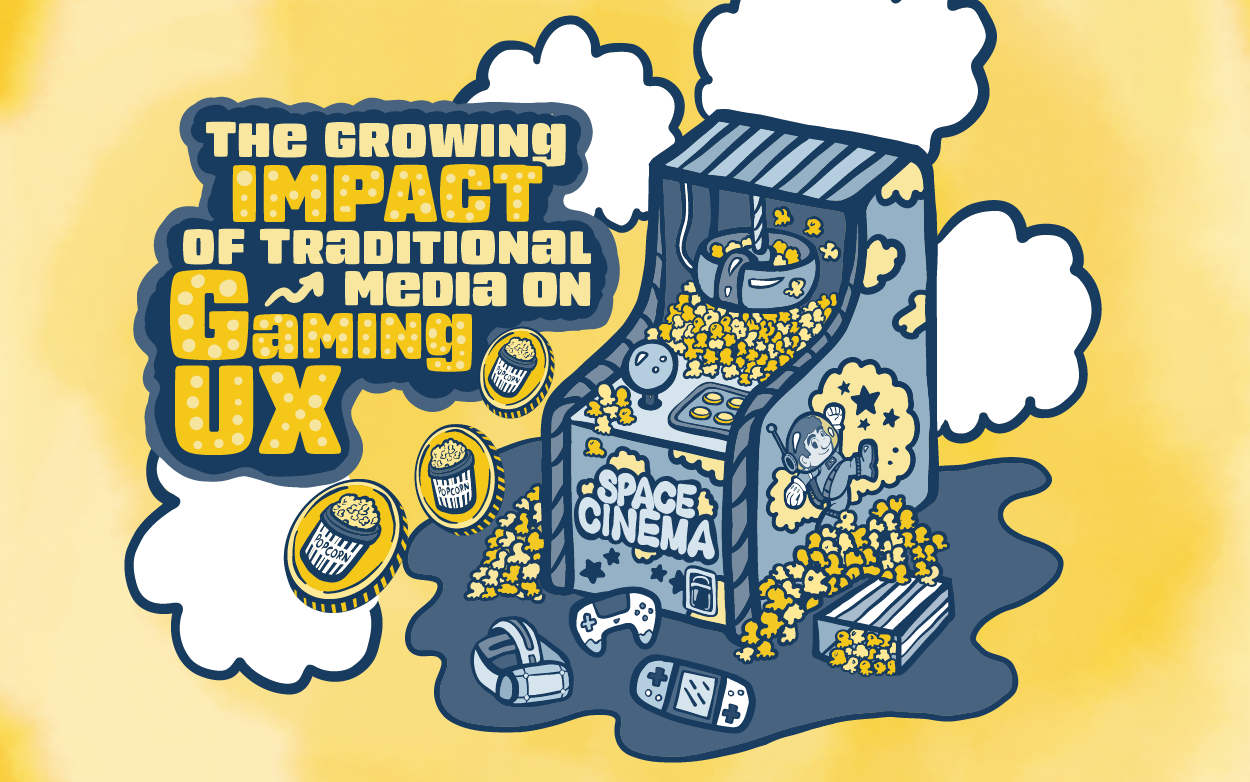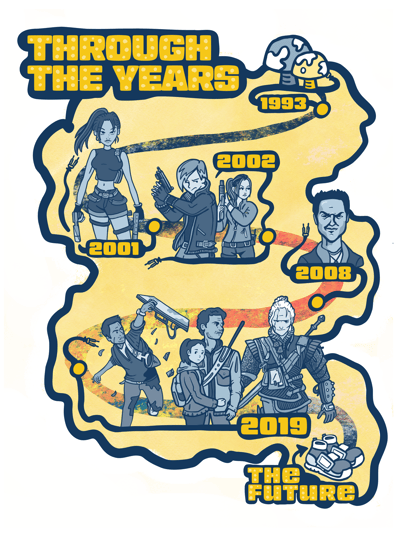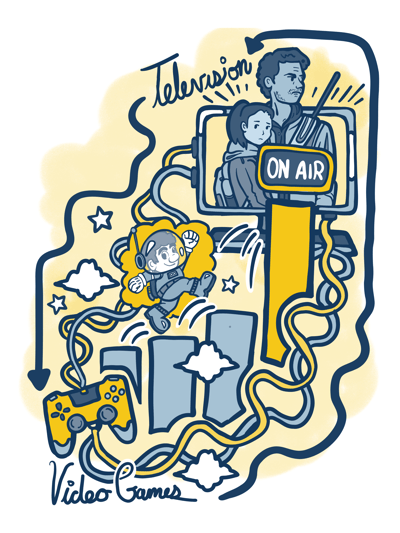In 2021, it’s estimated there are be 2.725 billion gamers worldwide, up from 2.341 billion in 2018. Games are played, wa...
The Growing Impact of Traditional Media on Gaming UX
As gaming and media become more intertwined, how can UX Research bridge the gap for immersive user experiences?

Posted by Ali Smith on Apr 10, 2024
The landscape of entertainment is rapidly evolving, and as such we are seeing that the sectors of gaming and traditional media are forming an increasingly symbiotic relationship, blurring the boundaries of what a user’s experience with a video game entails.
From gaming franchises getting produced into award-winning and record-breaking TV shows and films, to video streaming services releasing games of their own, to Esports navigating uncharted territory with new audiences and more, this shift is giving rise to a new era of content, transforming the way we interact with entertainment.
As technology advances and audience expectations evolve, we are seeing entertainment companies continue to push the boundaries on immersive experiences. This is an exciting time, one that presents fresh challenges and opportunities that UX design and research should account for along the way.
Gaming is becoming an increasingly important part of users’ lives, and design teams are needing to account for new user journeys beyond gameplay to help users learn how to engage with all of these new experiences. In this article, we explore some of the ways gaming and media are becoming more and more intertwined, and what it means for the future of user experiences in the entertainment industry.

Designs by Emily Pearsall, Art Director at AnswerLab
Cross-Media Franchises
TV and film adaptations of video games are not a new concept. The first theatrical release of a game-inspired movie in the US was Super Mario Bros. in 1993. Over the years, there have certainly been other big hits, including Lara Croft: Tomb Raider (2001), Resident Evil (2002), Max Payne (2008), and more.
Recently, though, we are witnessing a shift from video games existing solely within their own universes, to a growing number of cross-media franchises that span across various mediums, such as movies, TV shows, comic books, and even theme park attractions.
Game franchises like The Last of Us, Uncharted, Halo, and The Witcher have recently made successful transitions into the world of film and television, enhancing their narratives and expanding their fan bases. According to the Hollywood Reporter, the Last of Us’ cumulative audience of 30.4 million is the biggest for any HBO series since the final season of Game of Thrones in 2019. The upcoming docket of film adaptations of video games in the coming years include ones based on Borderlands, Sonic the Hedgehog, Minecraft, and Five Nights at Freddy’s (sequel), to name a few.
💡 What does this mean in the context of UX?
Translating these titles into different media formats keeps fans engaged with the universe in new ways, with additional depth to the storyline, characters, and world. It makes the content more accessible to a broader audience, including those who may not typically engage with video games, expanding their reach and impact. Additionally, it offers unique storytelling opportunities that may not be possible or practical within the constraints of a game, through cinematography, editing, and acting.
Some UX considerations:
- How do we identify elements of interactivity from games that can be translated into engaging viewing experiences, which are usually more passive than gaming?
- How do we account for games that feature multiple branching narratives, and translate those into a linear viewing format?
- How do users journey from one medium to another, and how do we best accommodate that?
AnswerLab Case Study: How can we understand and improve the online gaming experience for women?
Cross-Franchise Partnerships
Games like Fortnite have taken the concept of the crossover to a whole new level by introducing characters from various franchises into their gameplay. Examples include characters from popular animes (Naruto), TV shows (Rick and Morty), movies (Marvel’s Avengers), other games (League of Legends), as well as celebrities and public figures (LeBron James).

This innovative approach creates a shared gaming experience that transcends individual game worlds and brings together iconic characters from different universes. It not only sparks excitement from fans, but also expands the gaming landscape by introducing new narratives, unique abilities, and fresh gameplay mechanics.
This crossover trend not only amplifies the entertainment value of the game, but also reinforces the interconnected nature of gaming and media.
It also provides a marketing platform for these franchises, allowing them to reach a wider audience and rejuvenate interest in their respective content. Such can be said for the case study of the Travis Scott virtual concert in Fortnite, which, per a report from Forbes, reportedly earned the artist roughly $20 million. This was after a whopping 27.7 million unique players participated live in-game, according to Fortnite’s representatives.
Some UX considerations:
- How do we ensure that branding elements of each franchise are represented authentically while also creating synergy between brands?
- How do we maintain consistency in art style and thematic elements for a cohesive, aesthetic experience?
- If the partnership involves monetization elements like in-game purchases or microtransactions, how do we implement them in a way that feels fair, non-intrusive, and in-line with both brands?
AnswerLab Case Study: How can we improve the onboarding experience for child gamers?
Streaming Platforms: Gaming-Focused and
Gaming-Adjacent
 The rise of gaming-focused streaming platforms, like Twitch and YouTube Gaming, has propelled gaming further into the mainstream. Within these platforms, gamers are able to seamlessly live-stream their gameplay, providing an opportunity for millions of viewers to engage, chat, and even influence the gameplay in real-time, even if not gamers themselves.
The rise of gaming-focused streaming platforms, like Twitch and YouTube Gaming, has propelled gaming further into the mainstream. Within these platforms, gamers are able to seamlessly live-stream their gameplay, providing an opportunity for millions of viewers to engage, chat, and even influence the gameplay in real-time, even if not gamers themselves.
Author’s note: stumbling on and subsequently becoming a consistent viewer of a female Fortnite streamer in 2018 is what led to my resurged interest in gaming as an adult and passion for creating UX experiences that empower female gamers.
The fusion of gaming and media has given rise to a new wave of content creators/influencers – streamers – who entertain and connect with their audiences through their gaming prowess.
Historically, gaming began as a social experience, as players congregated to play in arcades, until home consoles rose in popularity and gaming became a solo venture in the domestic space. Now, with streaming platforms that encourage social interaction in the domestic space, we are now seeing a new and more impactful blurring-of-the-line effect between players and spectators.
Factor in that streaming platforms are replacing more traditional modes of entertainment in general, like cable TV, and the accessibility of being able to view this content on laptops, phones, tablets, etc., and you’ve got a recipe for endless possibilities.

Additionally, streaming giants, like Netflix, are increasingly expanding into gaming to tap into its potential. Utilizing their user base and infrastructure, they are developing original titles for subscribers, for now at no extra cost. This diversifies their offerings and seamlessly introduces streaming users into the foray of gaming.
By integrating gaming content, streaming companies engage users for longer periods and attract new audiences. They use their storytelling expertise to create immersive gaming experiences that resonate with subscribers, allowing for cross-promotion and crossovers with popular shows or movies.
In recent years, Netflix has launched a line of narrative-driven games, like Netflix Stories: Love is Blind, based on their popular reality show, and Bandersnatch, a choose-your-own-adventure film set within the world of Black Mirror. They recently announced exciting plans for nearly 90 more games that are in development, including Hades and a game variation of their hit show, Money Heist.

This convergence blurs the lines between streaming and gaming platforms, offering a unified entertainment experience. With their resources, these companies are already reshaping the gaming landscape.
Some UX considerations:
- How do we help users discover new games, streams, and creators, given the vast amount of content available?
- How do we enhance the sense of community within a platform, and ensure these features are easy to use, accessible, and enhancing rather than detracting from the experience?
- How do we maintain consistency in the user interface and experience across platforms (smart TVs, gaming consoles, mobile devices, PCs) for a seamless transition for users?
 Esports
Esports
The rise of esports has also brought together the realms of gaming and traditional sports entertainment. Esports events draw massive crowds, both online and in-person, and offer a spectacle that rivals traditional sports tournaments.
Market research firm MarketsandMarkets reported that the global esports market size was worth around $1.4 billion USD in 2022 and is predicted to grow to around $6.8 billion USD. The industry also experienced significant growth during the COVID-19 pandemic, largely due to being remote-accessible; it provided a compelling option for both players and spectators seeking entertainment from the safety of their homes. Millions of viewers tune in from all over the world, with a heavy participant rate in China, South Korea, and Japan, adding diversification into a primarily US-dominated gaming market.
Broadcasting networks have taken notice, with major media companies investing in esports broadcasting rights. This integration has led to increased mainstream exposure for gaming and has provided a platform for gamers to compete professionally and build lucrative careers.
The convergence of gaming and sports has created a new entertainment user experience that combines the thrill of competition with the spectacle of media production.
From a UX perspective, there is still much to learn. UX designers should cater to a wide range of users (casual gamers, hardcore enthusiasts, and professional players) with intuitive interfaces that accommodate different skill levels and preferences. They should ensure high-performance experiences with minimal latency and smooth gameplay, as split-second decisions can make a difference.
Additionally, they should aim to foster a sense of belonging, providing features that encourage user engagement, such as in-game chat, social sharing, and community forums. They should consider the vast amounts of data related to player performance, gameplay metrics, and user behavior (e.g., are they tuning in from home, bars, stadiums, etc.) and leverage these analytics to gain insights on how to improve the overall experience continually.

Another big conversation is around monetization. Esports presents various monetization opportunities, including in-game purchases, merchandise sales, sponsorships, and advertising (e.g., billboard ads in-game). It also has opened a market for esports betting/gambling. UX design plays a pivotal role in designing seamless, non-intrusive monetization strategies that enhance the user experience rather than detract from it.
Some UX considerations:
- How do we create a cohesive experience that is user-friendly to audiences of different viewing intentions and familiarity levels with gaming?
- How do we better understand the spectator experience and provide features that enhance viewers’ understanding and enjoyment of the game?
- How do we prioritize data metrics that can best serve future platform development?
AnswerLab Case Study: Electronic Arts (EA) asked "How do we develope a benchmark for future mobile game development?"
Virtual Reality
Virtual Reality (VR) has emerged as a game-changer, providing an unprecedented level of immersion, interactivity, and accessibility for users. It allows players to transport themselves from their living room to fully realized virtual worlds. It introduces innovative gameplay mechanics (like motion tracking, hand presence, and spatial audio), spawns new genres of exploration-based games and social environments, and generates more immersive narratives.
 Not only are users immersed in whole worlds, but they have become the heroes and heroines of these rich experiences. And, on the topic of the convergence with media, VR is taking hardware that is stereotypically associated with gaming and using it to introduce users to other forms of entertainment while in-headset.
Not only are users immersed in whole worlds, but they have become the heroes and heroines of these rich experiences. And, on the topic of the convergence with media, VR is taking hardware that is stereotypically associated with gaming and using it to introduce users to other forms of entertainment while in-headset.
Users are able to seamlessly jump back and forth between video games, concerts, social gatherings, and more. For example, you could switch between the video game, Resident Evil and a live virtual concert with artist T-Pain with a few clicks of a controller, transforming how we view the definition of gaming at its core.
In the context of UX, these exciting opportunities also present themselves with unique and interesting challenges. Developers are required to adapt to new design principles, optimize performance for VR hardware, and navigate the unique constraints of the medium. Which leads to more questions needing to be asked on the front-end: Are developers keeping accessibility considerations in mind for users of various wants and needs? Are the games themselves designed to make users feel safe and free from social harm, including statistically more at-risk groups like female gamers and youth gamers? Are designers capitalizing on this growing symbiosis with traditional media?
VR headsets are becoming more accessible and affordable, and the companies behind them are generating innovative ways to introduce them to even the least tech savvy of consumers. As such, we can expect gaming and media to become even more interconnected in the future.
Some UX considerations:
- How can the game immerse players fully in the virtual environment, and what techniques can be used to maintain engagement and avoid distraction with competing apps/VR events?
- How do we design gestures and game mechanics that feel immersive yet account for players’ levels of sensitivity with motion sickness/discomfort?
- What other opportunities exist to bridge the gap between VR gaming and traditional media to echo the successes of The Last of Us on HBO, Fortnite’s partnerships, etc.?
A New Era for Gaming UX
 The seamless integration of gaming and media has ushered in a new era of entertainment where boundaries blur and experiences intertwine. Production companies are increasingly adapting video game franchises into various media formats, like TV shows and movies, thus deepening their narratives and fandoms.
The seamless integration of gaming and media has ushered in a new era of entertainment where boundaries blur and experiences intertwine. Production companies are increasingly adapting video game franchises into various media formats, like TV shows and movies, thus deepening their narratives and fandoms.
Gaming-focused streaming platforms are creating an unprecedented social experience, while esports, VR platforms, and streaming giants’ expansion into gaming have made the medium more mainstream for newer users.
All of this is very exciting, and it signifies a transformative shift in the UX of how we consume and engage with entertainment. It fosters interconnectedness, accelerates learning curves, sparks collaborations, and provides new avenues for storytelling and interactive experiences.
The lines between gaming and media continue to blur, giving rise to innovative possibilities and new opportunities for creative expression. Users will need to know how to engage with all of these new experiences, emphasizing the need for UX research in these spaces to compete for, maintain, and grow audience attention.
Learn more about our how to transform your Gaming experience with UX Research.
Ali Smith
Ali Smith is a Principal UX Researcher at AnswerLab, where she leverages her wide breadth of expertise specializing in Gaming, AR/VR, Social Media, and AI research. Along with working closely with Fortune 500 clients to understand their users’ needs, she is passionate about mentoring aspiring UX researchers and actively contributing to the development and advancement of the field.related insights
Get the insights newsletter
Unlock business growth with insights from our monthly newsletter. Join an exclusive community of UX, CX, and Product leaders who leverage actionable resources to create impactful brand experiences.